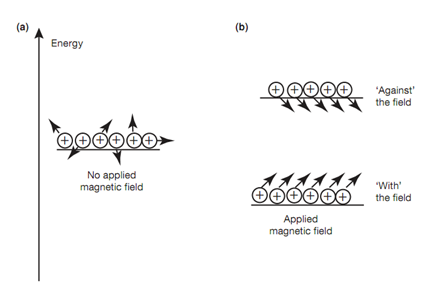External magnetic field:
The other orientation has the nucleus spinning like the dipole moment is pointed roughly against the field. Mainly, these two orientations are not of equivalent energy. The orientation against the field is much less stable as compared to the orientation with the field. This is vital to understanding why we get an nmr spectrum.

Figure: Energy levels before and after applying an external magnetic field.
The energy variation among the two orientations is very small and thus the energy levels involved are approximately equally populated. Though, there is a slight excess of nuclei in the much more stable energy level, and thus if we were to promote these nuclei to the higher energy level, energy will be absorbed and a Spectrum could be computed. Earlier than we look at what energy is needed, we shall return to our picture of the spinning nucleus. Figure depicts the nucleus spinning with the field - the much more stable orientation. Note that the dipole moment is not straight aligned with the magnetic field, but is at an angle to it. The meaning of this is that the dipole moment experiences a force or a torque that causes it to rotate or precess around the z-axis such as a gyroscope. A gyroscope is a spinning body which, while set at an angle to the vertical axis of gravity, precesses round that vertical axis. The nucleus is going through exactly the same kind of motion. It also is a spinning body but it precesses round the axis of an applied magnetic field. The rate at which the dipole moment precesses round the z-axis is termed as the Larmor frequency and is dependent upon the strength of the applied magnetic field. If the magnetic field rises, the rate of precession increases.